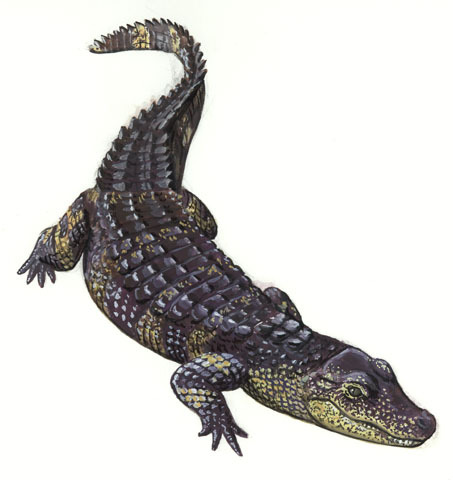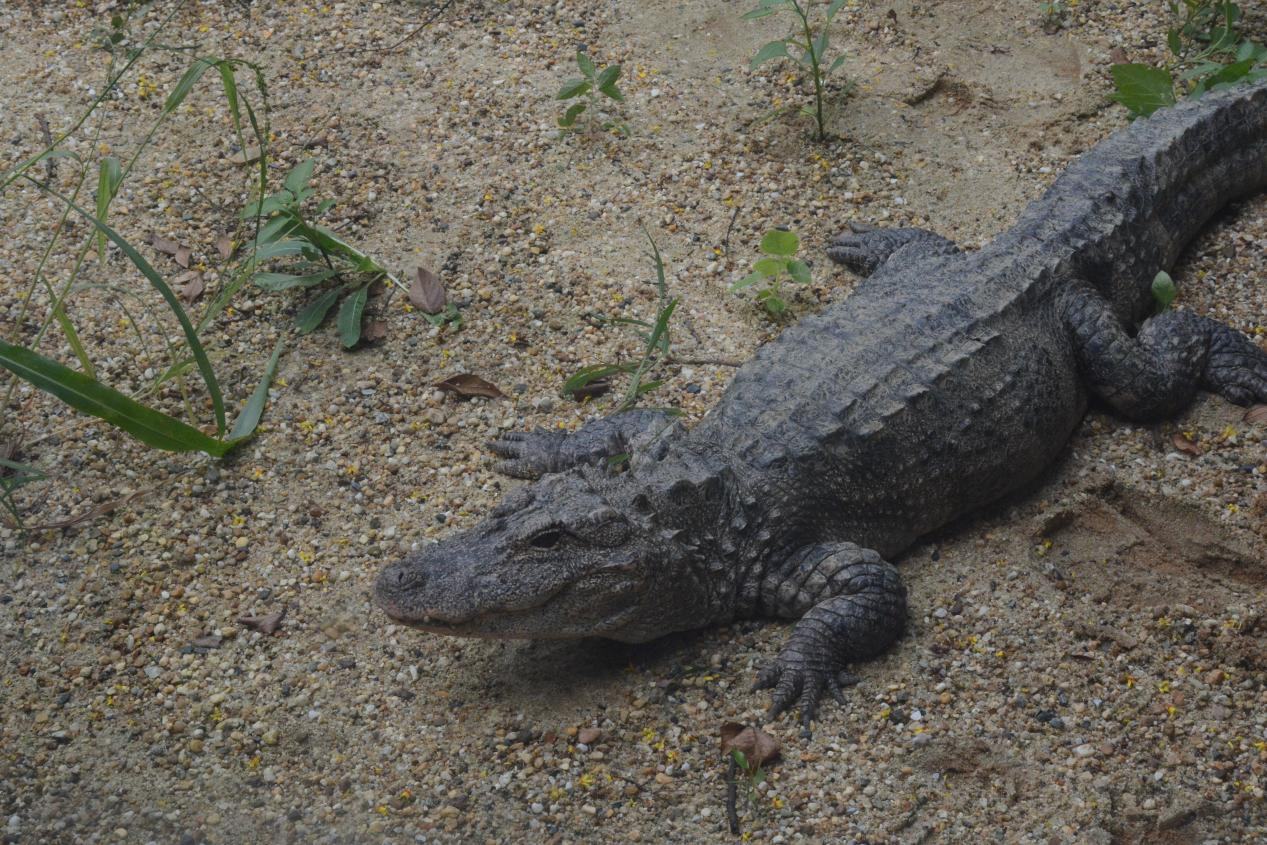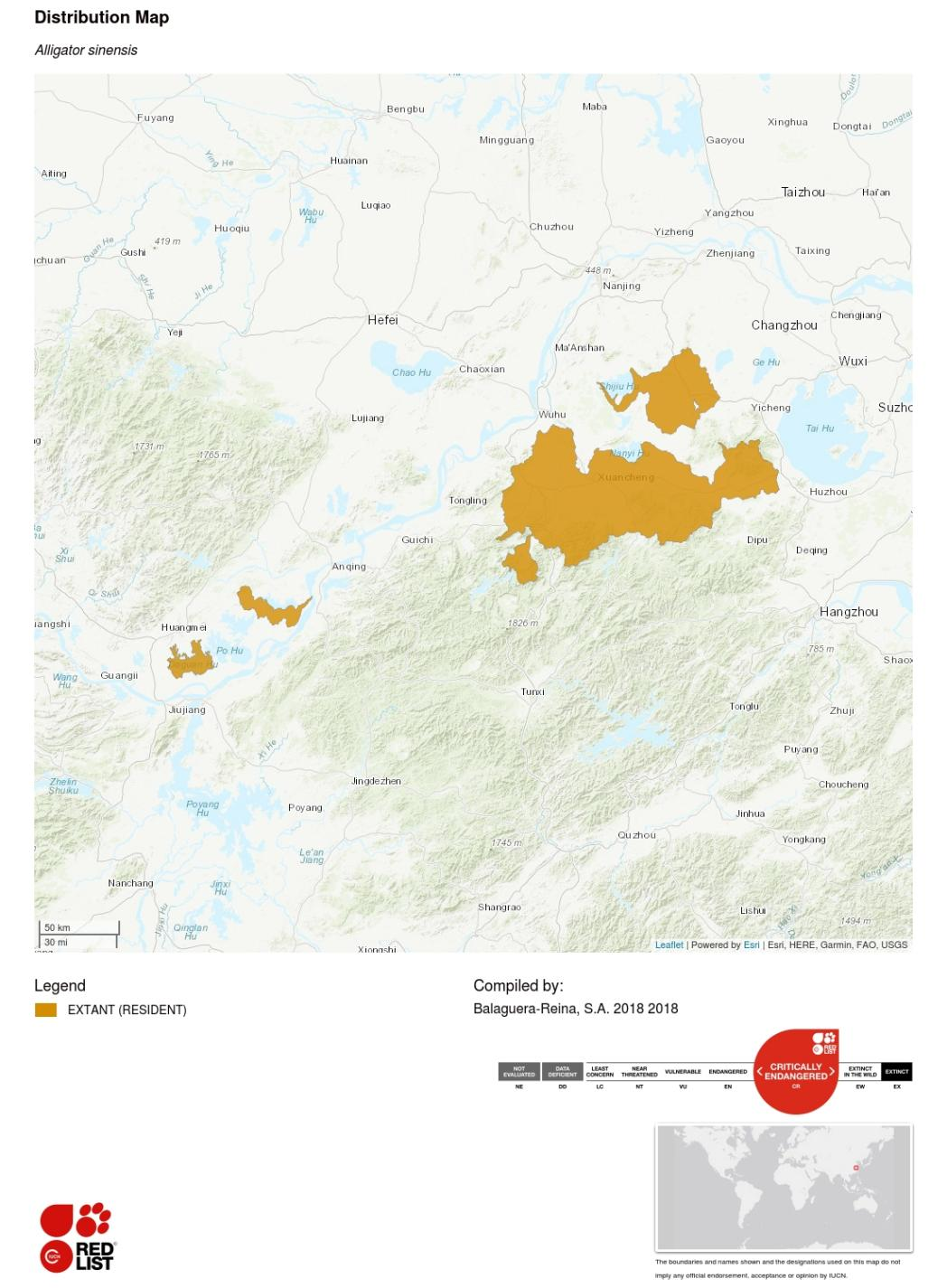扬子鳄Chinese Alligator
1. 分类Taxonomy
爬行纲Reptilia
鼍(tuó)科(短吻鳄科)Alligatoridae
鼍属(短吻鳄属)Alligator
扬子鳄Alligator sinensis(Fauvel,1879),英文名Chinese Alligator、 China Alligator、Yangtze Alligator
2. 保护级别Conservation assessment
l 国家一级重点保护野生动物
National first class key protected species of China
l IUCN红色名录极危物种
Critical Endangered species on IUCN Red List
l CITES(华盛顿公约/濒危野生动植物物种国际贸易公约)附录Ⅰ
Species on CITES appendix Ⅰ
3. 形态特征Physical Description
扬子鳄成年个体体长1.5米,已知最大个体2.37米,体重约60千克。四肢粗短,趾间有蹼,尾长而侧扁,粗壮有力,在水中可协助其移动(图1、2)。
扬子鳄浑身上下都有鳞甲,肚子上是方形,颈部体侧是凸起的圆形,背部和尾部是高高的扁锥形。
The body length of Chinese alligator adult is about 1.5 m, and the largest known individual is 2.37 m long, weighs about 60 kg. Their limbs are short, webbed between the toes, and their tail is long and flat, thick and strong, which helps them move in water (Fig. 1, 2).
Chinese alligator has scales all over the body, which are square on the belly, round and prominent on the neck side, prominent, flat and cone on the back and tail.

图1. 扬子鳄外形示意图(作者Michigan Science Art,来源Animal Diversity Web)
Figure 1. Chinese alligator (contributor: Michigan Science Art; origin: Animal Diversity Web

图2. 扬子鳄实体图(作者常娟,来源红山动物园)
Figure 2. Chinese alligator (contributor: Chang Juan; origin: Hongshan Zoo)
4. 地理分布Geographic Range
现生存于长江中下游的安徽、江苏和浙江三省毗临的长江及其支流地区(图3)。
It now lives in the middle and lower reaches of the Yangtze River and its tributaries in Anhui, Jiangsu and Zhejiang provinces (Fig. 3).

图3. 扬子鳄世界范围地理分布(来源IUCN)
Figure 3. Geographic range of Chinese alligator (origin: IUCN)
5. 栖息环境Habitat
扬子鳄的栖息地主要位于:
① 残留湿地,一般是沿着主河道、低洼、宽阔、肥沃的山谷。目前已基本被稻田占领。
② 支流山谷间的池塘。
此外,扬子鳄在其栖息地内均有复杂的洞穴系统。有冬眠休息的卧台,有调节温度的水潭,还有应对洪水暴涨作为逃生出口的气孔。
The habitats of Chinese alligators are mainly:
① Residual wetlands, which are generally low-lying, wide and fertile valleys along main river channels. It is now largely occupied by rice fields.
② Pond in a valley of tributaries.
In addition, Chinese alligator has a complex cave system in its habitat with beds for hibernation, pools for temperature regulation, and air holes for escape in case of flood surges.
6. 生活习性Ecology
6.1 食物Food Habits
肉食性动物。主要食物有鱼、蛙和河蚌。
扬子鳄摄食的时间主要为5-9月,其中最旺盛的是在6-8月,占全年摄食量的80%以上。
扬子鳄的牙齿是捕猎的重要武器,为了保持牙齿的锋利,它们可以终生定期更换牙齿。它们拥有强大的咬合力,却不能咀嚼食物,食物总是直接吞下。
Chinese alligators are carnivorous animals, whose main food includes fish, frogs and mussels.
Chinese alligator feeding period is mainly from May to September, the most vigorous period is in June to August. The food amount they consume during these time accounting for more than 80% of the annual intake.
Chinese alligators' teeth are important hunting weapons, which could be regularly replaced throughout lifetime to keep them sharp. They have a powerful bite force, but they can't chew their food, so they just swallow it directly.
6.2 社群Sociality
一般独居。
Chinese alligators are usually solitary.
6.3 领域Home Range
进入扬子鳄的生活区,你可能会闻到一股特别的味道,用于标识地盘。它们有两种臭腺:下颌腺和泄殖腔腺,这两种腺体都能分泌出特殊气味的油脂状物质。
When near the living place of Chinese alligators, you may smell a special odor, which are used by the alligators to mark territory. They have two types of odor glands: the mandibular gland and the cloaca gland, both of which secrete greasy substances with particular smells.
6.4 节律Rhythm
扬子鳄的活动状态因温度而定,春季温度较低时,它们喜欢在向阳的岸边晒太阳,或叠罗汉;在炎热的夏季,扬子鳄一般喜欢待在水中避暑。
10月中下旬气温低于10℃时,它们进入冬眠期,直到次年4月苏醒。
The activity state of the Chinese alligator depends on the temperature. When the temperature is low in spring, they like to bask in the sunshine on the shore, or pile up together. In hot summer, Chinese alligators like to stay in the water to escape the heat.
When the temperature falls below 10℃ in mid-to-late October, they go into hibernation until they wake up in April.
7. 繁殖Reproduction
自然界中的雌性扬子鳄远比雄性多,雌雄比例约为5:1。
一夫多妻制。6月中上旬发情、交配,7月产卵。
野生鳄性成熟年龄尚未清楚,估计野生鳄的雄性成熟年龄为9-10岁,雌性为10-11岁;人工饲养的鳄,性成熟年龄为雄性5-6岁,雌性6-7岁。
求偶以呼叫为前奏,声音响亮。雄雌一呼一应,雌的叫声较低沉,雄的叫声较洪亮。雄雌相聚,拥抱交尾。
孵化期间,母体并不远去,且不时来到巢边视察或守卫。一巢产10-40枚蛋,60-70天孵化破壳。凡是30℃以下孵化出来的幼鳄全是雌性,凡是34℃以上孵化出来的全是雄性,31℃-34℃之间孵化出来的,有雌有雄,但雌总多于雄。
扬子鳄有护卵习性,但不同的鳄护卵行为的强弱表现很不相同。有些扬子鳄还有护雏行为。
雏鳄完全出壳后,即独立,并离巢而去,以后不再回巢。
There are more female Chinese alligators than males in nature, and the ratio of female to male is about 5:1.
The alligators are polygamy. Estrus and mating season are early June and oviposition is in July.
The age of sexual maturity of Chinese alligators in wild is still unknown. It is estimated that the age of sexual maturity of Chinese alligators in wild is 9-10 years old for males and 10-11 years old for females. In captivity, Chinese alligators reach sexual maturity at 5 to 6 years for males and 6 to 7 years for females.
Courtship begins with a loud call. The male and female call and respond, the female's call is deeper, the male's call is louder. The male and female meet and copulated.
During incubation, the mother does not travel far, but comes to inspect or guard the nest frequently. A female will lay an average of 10-40 eggs and hatch them in 60-70 days. All hatchlings below 30℃ are female, all hatchlings above 34℃ are male, and those hatchlings between 31℃ and 34℃ are both male and female, but there are always more females than males.
Chinese alligators have the habit of protecting eggs, but different alligators have different behaviors of protecting eggs. Some Chinese alligators also protect their young.
Once fully hatched, the young become independent and leave the nest, never to return again.
8. 保护现状Conservation Status
生境改变及过度捕猎是导致扬子鳄数量下降的主要原因。2017年,中国野生扬子鳄数量约为300条,其中一些是曾是人工圈养后再放归野外的个体。
目前政府开展了大量的针对扬子鳄的保护工程:1972 年列为 I 级重点保护野生动物,并在 1978 年和 1979 年先后在安徽宣州和浙江长兴成立扬子鳄繁殖研究中心。人工圈养保护、野外就地保护、繁殖子代放归以及重引入等一系列的保护计划给野生扬子鳄种群的复壮工程带来希望。宣城鳄鱼湖即安徽省扬子鳄繁殖研究中心,是我国最大的扬子鳄保护基地,经过20年的人工饲养繁殖,扬子鳄数量已由当初野生收集到的140余条,增加到1万余条,并具备年繁殖1500条的能力,扬子鳄已渡过“濒危线”。这一成果获得了国际社会的肯定和赞誉。
Habitat change and overhunting are the main reasons for the decline of Chinese alligator populations. In 2017, there were about 300 Chinese alligators in wild in China, some of the individuals were raised in captivity and then released into the wild.
Till now, the government has carried out a large number of protection projects for the Chinese alligator. In 1972, the Chinese alligator was listed as a class I key protected wild animal. and in 1978 and 1979, the Chinese alligator breeding research center was set up in Xuanzhou, Anhui province and Changxing, Zhejiang Province. A series of conservation programs, such as captive breeding, in situ conservation, reproduction and reintroduction, bring hope to the restoration project of wild Chinese alligator population. Alligator Lake of Xuancheng, Anhui Province Research Center of Alligator Breeding, is China's largest Protection base for Chinese alligators. After 20 years of artificial breeding, the number of Chinese alligators has increased to more than 10,000 from the original wild collection of more than 140, and has the ability to breed 1,500 a year, Chinese alligators have crossed the "endangered line". This achievement has won recognition and praise of international level.